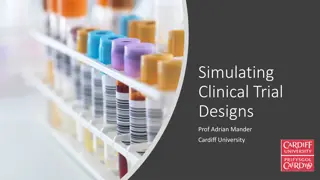Anatomy of a Trial: Structure and Procedures Explained
Understanding the anatomy of a trial is crucial for legal professionals. This detailed guide covers the composition of the legal teams, order of events in a trial, opening statements, witness examinations, and closing arguments. It provides insights into the roles of prosecution, defense, attorneys, and witnesses, along with the importance of presenting a strong case and conducting effective examinations.
Download Presentation

Please find below an Image/Link to download the presentation.
The content on the website is provided AS IS for your information and personal use only. It may not be sold, licensed, or shared on other websites without obtaining consent from the author.If you encounter any issues during the download, it is possible that the publisher has removed the file from their server.
You are allowed to download the files provided on this website for personal or commercial use, subject to the condition that they are used lawfully. All files are the property of their respective owners.
The content on the website is provided AS IS for your information and personal use only. It may not be sold, licensed, or shared on other websites without obtaining consent from the author.
E N D
Presentation Transcript
Composition of Team (for Competition) Prosecution/Plaintiff 3 Attorneys 3 Witnesses Defense/Defendant 3 Attorneys 3 Witnesses
Order of Events in Trial 1. Prosecution/Plaintiff Opening Statement 2. Defense/Defendant Opening Statement 3. Examination of Prosecution/Plaintiff Witness No. 1 Cross Examination by Defense/Defendant Possible Re-direct by Prosecution/Plaintiff Possible Re-cross by Defense/Defendant 4. Examination of Prosecution/Plaintiff Witness No. 2 Cross Examination by Defense/Defendant Possible Re-direct by Prosecution/Plaintiff Possible Re-cross by Defense/Defendant 5. Examination of Prosecution/Plaintiff Witness No. 3 Cross Examination by Defense/Defendant Possible Re-direct by Prosecution/Plaintiff Possible Re-cross by Defense/Defendant
Order of Events in Trial (Continued) 6. Examination of Defense/Defendant Witness No. 1 Cross Examination by Prosecution/Plaintiff Possible Re-direct by Defense/Defendant Possible Re-cross by Prosecution/Plaintiff 7. Examination of Defense/Defendant Witness No. 2 Cross Examination by Prosecution/Plaintiff Possible Re-direct by Defense/Defendant Possible Re-cross by Prosecution/Plaintiff 8. Examination of Defense/Defendant Witness No. 3 Cross Examination by Prosecution/Plaintiff Possible Re-direct by Defense/Defendant Possible Re-cross by Prosecution/Plaintiff
Order of Events in Trial (Continued) 9. 10. Prosecution/Plaintiff Closing Argument Defense/Defendant Closing Argument
Opening Statement Gives explanation of trial to jury before examinations begin Should include: Theme of your counsel s case (which will also be used in the closing argument) Introduction of counsel members Duty of jury Explanation of pleadings Explanation of what counsel must prove to win the case Introduction to witnesses and broad explanation of what they will testify to (NO specific details)
Examination- Questioning of a witness Direct Examination Attorney questions his/her own witness (who will testify to help the attorney s side of the case) Open ended questions o Allow for thorough explanation in answers Cross Examination Attorney questions the opposing counsel s witness (who will testify to help the opposing side of the case) Leading questions- questions which have an expected answer o Yes or No questions
Closing Argument Reiterates points brought up in trial Brings together all arguments in a cohesive case theory Should include: Theme of your counsel s case (which will also be used in the opening statement) Explanation of pleadings Explanation of what counsel has proven to win the case Facts brought up in witness examinations Holes in opposing counsel s case Persuasive conclusion (asking jury to fulfill their duty and make the correct ruling)
Time Limits Opening Statements: 5 minutes maximum (per side) Examinations (including re-direct and re-cross): 30 minutes maximum (per side) Closing Arguments: 5 minutes maximum (per side)























